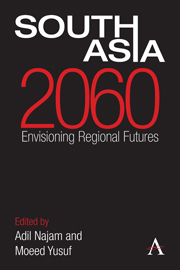Book contents
- Frontmatter
- Contents
- Acknowledgments
- List of Abbreviations
- Introduction: Imagining South Asian Futures
- Section I South Asia as a Region
- Section II State Relations
- Section III Development
- Chapter 16 South Asian Economy in 2060
- Chapter 17 Economic Futures: Challenges Ahead
- Chapter 18 South Asia in the Asian Economy: Struggling to Overcome History
- Chapter 19 Globalization and South Asia
- Chapter 20 Trade Relations: Some Predictions and Lessons
- Chapter 21 Urban Policy for Environmental Quality and Well-Being
- Chapter 22 Urban Futures, Urban Challenges
- Chapter 23 Water Security: Risks and Responses
- Chapter 24 Agriculture and Food Security
- Chapter 25 Meeting Electric Power Demand in South Asia
- Chapter 26 E-South Asia: A Social Science Fiction
- Section IV Human Well-Being
- About the Authors
- Bibliography
- Index
Chapter 25 - Meeting Electric Power Demand in South Asia
from Section III - Development
Published online by Cambridge University Press: 05 September 2013
- Frontmatter
- Contents
- Acknowledgments
- List of Abbreviations
- Introduction: Imagining South Asian Futures
- Section I South Asia as a Region
- Section II State Relations
- Section III Development
- Chapter 16 South Asian Economy in 2060
- Chapter 17 Economic Futures: Challenges Ahead
- Chapter 18 South Asia in the Asian Economy: Struggling to Overcome History
- Chapter 19 Globalization and South Asia
- Chapter 20 Trade Relations: Some Predictions and Lessons
- Chapter 21 Urban Policy for Environmental Quality and Well-Being
- Chapter 22 Urban Futures, Urban Challenges
- Chapter 23 Water Security: Risks and Responses
- Chapter 24 Agriculture and Food Security
- Chapter 25 Meeting Electric Power Demand in South Asia
- Chapter 26 E-South Asia: A Social Science Fiction
- Section IV Human Well-Being
- About the Authors
- Bibliography
- Index
Summary
There are a number of reasons for focusing on what will propel development in South Asian countries (SACs). The most compelling is the intersection of demographics and poverty. The SACs considered here (Afghanistan, Pakistan, India, Nepal, Bangladesh, Bhutan, Myanmar and Sri Lanka) are home to about 24 percent of the world population, and this fraction is predicted to grow to 26.5 percent by 2050. Most monitoring agencies estimate that about 70 percent of the total population of SACs (1,150 out of about 1,640 million in 2009) lives below the poverty line (on less than $2ppp/day). Demographically, SACs consist of a number of ethnic communities that are widely distributed and, in many cases, ethnic and religious affiliations remain stronger than even national identity. While there is significant emigration to developed countries, especially of highly trained people, the total numbers compared to the total population are small. Mass migration out of the Subcontinent is an unlikely scenario as there are no new frontiers beckoning nor are there enough other countries that need hundreds of millions of untrained immigrants.
Power and Development in the SACs
Contemplating about the future of this large population, and whether the region possesses adequate resources to develop, as well as what development means to each of these countries, therefore, remain very timely issues. Without a doubt, governance will play a pivotal role at every level of the development process and determine the outcomes. There are large variations in governance within SACs, ranging from repressive to dysfunctional to barely functional. Each of the eight countries has a different political system, and all SACs except Bhutan are facing issues of civil and political unrest with multiple insurgencies.
- Type
- Chapter
- Information
- South Asia 2060Envisioning Regional Futures, pp. 192 - 200Publisher: Anthem PressPrint publication year: 2013

